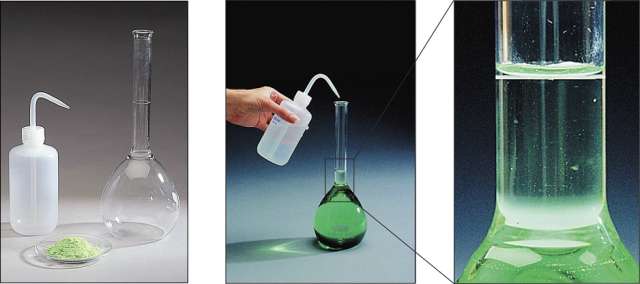Aqueous
Solutions - Molarity
An aqueous solution consists of at least two components, the solvent (water) and the solute (the stuff dissolved in the water). Usually one wants to keep track of the amount of the solute dissolved in the solution. We call this the concentrations. One could do by keeping track of the concentration by determining the mass of each component, but it is usually easier to measure liquids by volume instead of mass. To do this measure called molarity is commonly used. Molarity (M) is defined as the number of moles of solute (n) divided by the volume (V) of the solution in liters.

It is important to note that the molarity is defined as moles of solute per liter of solution, not moles of solute per liter of solvent. This is because when you add a substance, perhaps a salt, to some volume of water, the volume of the resulting solution will be different than the original volume in some unpredictable way. To get around this problem chemists commonly make up their solutions in volumetric flasks. These are flasks that have a long neck with an etched line indicating the volume. The solute (perhaps a salt) is added to the flask first and then water is added until the solution reaches the mark. The flasks have very good calibration so volumes are commonly known to at least four significant figures.
Example #1 :
Molarity Calculation
The equation for calculating Molarity from the moles and volume is very simple. Just divide moles of solute by volume of solution.
Molarity (M) = moles of solute / volume of solution (in liters) |
What is the molarity (with the correct numbers
of significant
figures) of a 0.40 moles of NaCl dissolved in 0.250 liters?
Example #2 :
Making Dilutions
A solution can be made less concentrated by dilution with solvent.
If a solution is diluted from V1 to V2, the molarity
of that solution changes according to the equation:
M1
V1 = M2 V2 Moles of solute in original solution 1 = Moles of solute in diluted solution 2 |
The volume units must be the same for both volumes in this equation. In general, M1 usually refers to as the initial molarity of the solution. V1 refers to the volume that is being transferred. M2 refers to the final concentration of the solution and V2 is the final total volume of the solution.
Remeber that the number of moles of solute does not change when more solvent is added to the solution. Concentration, however, does change with the added amount of solvent. (illustration)
Don't forget this concept. You will use it again in acid-base equilibrium.
Dilution calculation example:
How do you prepare 100ml of 0.40M MgSO4 from a stock solution of 2.0M MgSO4?
Answer:
There are two solutions involved
in this problem. Notice that you are given two concentrations, but only
one volume. Solution #1 is the one for which you have only concentration
- the solution that is already sitting on the shelf. Solution #2 is the
one for which you have both concentration and volume - the solution that
you are going to prepare.
At least until you are comfortable with this type of problem, it may be helpful to write out what numbers go with what letters in our equation.
M1 = 2.0M MgSO4
; V1 = unknown
M2 = 0.40M MgSO4 ; V2 = 100ml